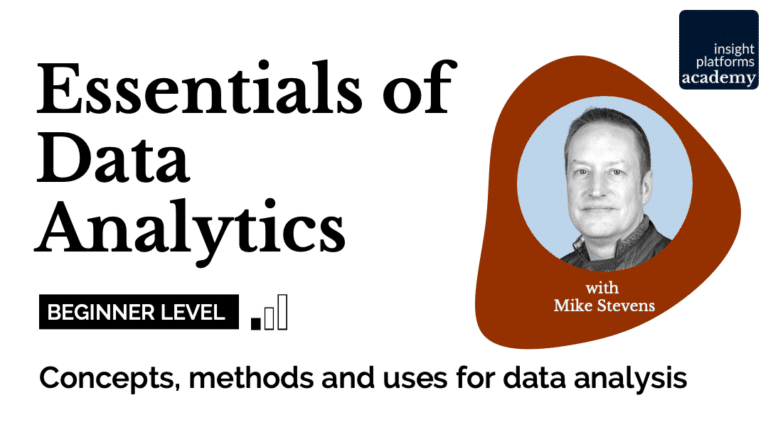
What is Data Analytics?
By Insight Platforms
- article
- explainer
- Data Analytics
- Statistics and Data Science
- Qualitative Data Analysis
- Statistical Analysis
- Advanced Statistical Techniques
- Multivariate Stats and Modelling
- Trend Analytics
- Data Visualisation
- Predictive Analytics
Almost all insights come in handy when it comes to understanding human behavior, but most researchers know that there’s nothing quite as satisfying as ‘crunching numbers’ to make decisions with resolve.
30 years of advancements in statistical methods, computing power, and access to larger volumes of data have led to a major surge in the number of organizations opting for a data analytics ‘numbers never lie’ approach to business – but what does this really mean?
What is data analytics all about, and how far can data it take us in investigative research?
Check out our Essentials of Data Analytics course to get a deeper understanding of the basic principles, methods and uses for data analytics.
How data analytics affects us all
Data analytics is a systematic process of examining and interpreting data to make informed decisions, identify opportunities, and stay ahead of the curve when it comes to competition and accurate decision-making.
Some common ways you’ve probably encountered data analytics as a consumer include:
- If you are a Facebook user, the platform uses data from two billion users to tailor its newsfeed, recommend connections, and target advertising
- If you’ve ever purchased something from Amazon, the company uses data from customers’ browsing, buying, and streaming habits to promote relevant offers
- If you have a membership with Netflix, they use data on members’ content choices and viewing behaviors to inform program development and make recommendations
- If you use Google to do day-to-day desk research, the platform’s search, maps, and mobile services generate billions of data points daily which are used to improve algorithms and serve advertising
Consumer Packaged Goods (CPG) companies are also leveraging data analytics to revolutionize their operations and stay ahead in a competitive market by using insights into consumer preferences, purchasing behavior, and market trends. For these businesses, diving into data isn’t just about numbers; it’s about reading the room and predicting the next big thing.
For example, here are few ways CPG companies are using data analytics:
- P&G uses weather data to forecast short-term demand increases for its Pantene hair care brand
- PepsiCo uses social media data to forecast consumer trends and focus on beverage and snack-food innovation
- Mondelez uses retailer data to analyze shopper baskets and plan seasonal coffee promotions
- Nestle Waters has a US data analytics command center for analyzing real-time social media and retail sales data to plan shopper activation and digital campaigns
What are the main benefits of data analytics for consumer insight?
Data analytics enables businesses to make informed decisions, enhance their strategies, and tailor their products and services to meet specific customer needs – ultimately improving customer satisfaction and loyalty.
The benefits of data analytics for consumer insight extend beyond just understanding current behaviors; they empower businesses to stay ahead in a competitive market by anticipating and adapting to evolving consumer demands.
Compared with general survey research, data analytics offers several distinct advantages:
Accuracy – Data analytics projects typically use inputs from ‘behavioral’ sources such as e-commerce transactions, GPS location databases and web tracking, which capture actual behavior rather than reported behavior in surveys and offer a higher degree of accuracy and reliability.
Duration – Many data analytics projects build long-term ‘models’ whose data can be updated regularly. This stops the model going out of date and improves its accuracy over time. You will learn more about the definition of models later in this course.
Integration – Data sources can often be connected together to increase the depth of analysis. Individual data records can be matched using a shared ‘linking’ variable such as User ID or email address, and data from different software systems can be connected using programming tools called APIs
Visualization– Data analytics projects can visualize huge quantities of information using interactive dashboards for drill-down or slice-and-dice queries. This enables analysts to conduct exploratory investigations, examine many different scenarios, and compare between sub-groups easily.
Automation – Sources of data can be connected to models, reports, and visualizations automatically. This means that models and dashboards can update (‘refresh’) in real-time as new data is available, without the need to create new charts or presentations
Scale – Data analytics sources often contain millions of data points, increasing representation for more confident predictions and supporting robust sub-group analysis.‘A/B Tests’ of different web pages often use samples of tens of thousands of visitors. This scale is not feasible in ad hoc research
Four related concepts that are key for understanding analytics
Data analytics can be grouped into descriptive, diagnostic, predictive, and prescriptive approaches:
Descriptive analytics
Descriptive analytics involves summarizing data to depict past or current situations, often serving as the initial exploratory steps in analytics projects – this method looks to answer the question, “What happened?”
Diagnostic analytics
Diagnostic analytics involves a thorough analysis of data to understand root causes through drill-down analysis, aiming to provide detailed insights and identify patterns – this process provides answers to the question, “Why did it happen?”
Predictive analytics
Predictive analytics involves analyzing data to assess the strength of historical patterns of change, informing the level of confidence in predicting that trends will continue in the future – this process typically addresses the question, “What’s likely to happen?”
Prescriptive analytics
Prescriptive analytics involves employing advanced analytical techniques to recommend specific courses of action, creating models that assign value scores to likely outcomes for a range of possible choices – this operation focuses on the question, “What should we do?”
To help you remember these concepts, use the acronym: DDPP.
Understand key terminology used in data analytics
Understanding key terminology in data analytics is paramount for having a foundational framework for effective communication and collaboration.
Knowing what these terms mean isn’t just about sounding smart; they signify specific methodologies and objectives that allow professionals to articulate their analytical approaches, discuss insights, and align strategies with accuracy and awareness.
Here are 4 terms you should spend time getting familiar with in order to better navigate data-analytics conversations and topics.
Data Science
The term ‘Data Science’ involves three key components: Programming & Data Management, Visualisation & Storytelling, and Statistical Analysis.
- Programming & Data Management involves tasks like organizing, cleaning up, putting together, and dealing with data – which folks like to call ‘data wrangling.’ It helps to know your way around software, be familiar with programming languages like R or Python, and be savvy with database query languages like SQL to make sense out of data.
- Statistical Analysis refers to the systematic collection, organization, analysis, and interpretation of data, with the application of appropriate statistical tests and models.
- Visualization & Storytelling consists of utilizing visualization tools like Tableau or Qlikview to employ dynamic chart resources that effectively communicate and report results to stakeholders.
Structured & Unstructured Data
When working with data analytics, you must understand the differences and definitions of Structured Data and Unstructured Data.
Structured data is organized textual information arranged in columns and rows, similar to a well-organized Excel worksheet, facilitating easy ordering, processing, searchability, and manipulation for calculations.
Unstructured data, in contrast, is typically expressed in natural language, lacking a defined data model such as consistent columns or rows, making it challenging for basic software to search, organize, or comprehend. Examples of unstructured data are documents featuring unformatted open-ended survey responses.
Models & Algorithms
Next up, let’s talk about Models and Algorithms in the realm of data analytics:
Models are commonly used to make predictions and forecasts, using a combination of calculations and variables to come up with original insights. In real-life situations, these models consider a number of different factors to guess how much people are willing to pay, how much of the product will sell at different prices, and what price will give the best bang for the buck in terms of revenue or profit.
Algorithms are sets of rules that outline a sequence of steps to execute a particular computation or task, essentially serving as a structured guide for problem-solving. They take inputs and process them through a defined set of instructions to generate an output.
Machine Learning and Artificial Intelligence (AI)
Lastly, seeing as we are currently in the Golden Age of technology, it wouldn’t be right if we failed to include the terms Machine Learning and Artificial Intelligence (AI).
Machine Learning forms the backbone of most present artificial intelligence, employing algorithms to discover patterns and acquire the ability to make predictions and recommendations through data processing. These algorithms evolve and improve over time by adapting to new information.
Artificial Intelligence enables machines to execute cognitive functions (or processes associated with human minds) like thinking, learning, and problem-solving, and even creative processes. It involves machines emulating human-like mental processes, with solutions spanning from robotics, self-driving vehicles, computer vision, and language.
4 need-to-know data science methods
Data analytics leverage a variety of statistical techniques, algorithms, and modeling approaches. There are 4 fundamental concepts worth understanding as a prerequisite to data analytics: Correlation, Classification, Clustering, and Regression.
Each method serves a different purpose in analytics, but they are also versatile allowing them to be applied across the four analytical domains descriptive, diagnostic, predictive, and prescriptive (Remember DDPP?).
Correlation
Correlation measures the strength of the relationship between pairs of variables: positive correlation indicates that an increase in one variable is matched by an increase in another, and negative correlation indicates that an increase in one variable is matched by a decrease in another. The correlation coefficient, using r values from -1.0 to +1.0, tells you how strong their connection is.
However, it’s important to note that correlation does not imply causation, meaning that just because two variables are correlated, one doesn’t necessarily cause the change in the other.
Classification
Classification is a method in consumer segmentation where individuals are assigned to specific groups or segments. These segments are determined by factors such as consumer attitudes, behaviors, responsiveness to offers, and relevance for targeted messaging.
In classification tasks, models are developed to categorize individuals into specific classes based on either observable factors, such as whether a consumer purchased a product, or through scores and class probability estimates.
Clustering
Clustering is an exploratory data-driven approach that seeks to identify natural groupings among customers, focusing on the smallest variations within each group. In contrast to rules-based segmentation, which relies on predetermined criteria, clustering facilitates segmentation across multiple dimensions, resulting in more homogeneous segments. Common clustering techniques encompass behavioral, product-based, category-based, and brand-based approaches.
However, we must warn you to exercise caution with clustering. This data-driven approach can potentially result in numerous segments and unexpected outcomes. Managing these outcomes may be challenging, emphasizing the importance of aligning the analytics solution with specific business needs.
Profiling
Profiling is all about understanding individuals or groups better by considering further and more specific details. This information includes demographics such as age, education, income, and factors like spending habits, purchased products, and online behavior. This approach utilizes index measures to quickly compare insights from individuals with the entire population to uncover a clearer picture and understanding of data and insights aligned with research objectives.
A final note on data analytics
Grasping the ins and outs of data analytics takes a nuanced understanding of the intricacies and processes involved in extracting insights, data, and research efforts.
Data analytics is not just about working through data; it’s about tapping into its potential.
By investing the time to educate yourself on all things analytics, you will be able to more precisely interpret results and reveal patterns and trends that might otherwise be overlooked.
Have a look at our Essentials of Data Analytics course to get a deeper understanding of the basic principles, methods and uses for data analytics.


